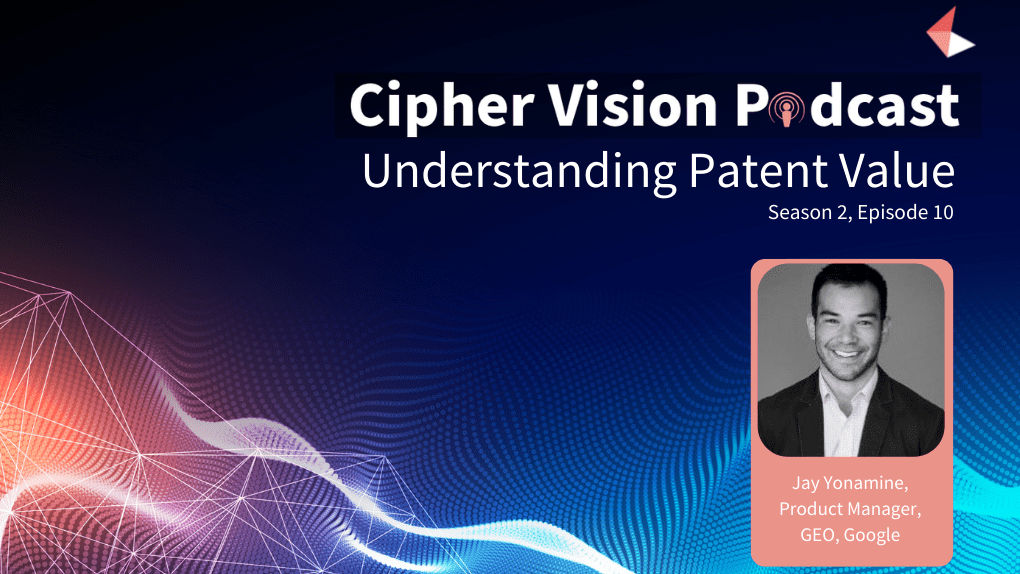Understanding Patent Value

Guest:
- Jay Yonamine, Product Manager, GEO at Google.
Episode Highlights
Entering the world of IP and overcoming barriers
On bringing data scientists into the patent world
There are definitely a couple of folks scattered in industry who are essentially embedded within a patent or a legal organization, or full-time doing data science work, but it’s rare. I don’t know of any dedicated teams in industry.
I think when you just look at what you can do with advanced analytics, advanced machine learning, artificial intelligence, it’s tremendous, and the potential impact is massive. I think every team should be thinking about this.
I would really make sure and highly advise doing two things. First, making sure that senior leadership is really bought into the idea of bringing on someone to do this type of work, knowing that it may disrupt the status quo, may provide a new way of looking at things. It may just be a little bit of a culture shock, both to the data science person or team coming in, as well as the existing patent counsel and legal ops folks.
Secondly, I would advise if you’re wanting to make that jump to bring someone on, get someone senior, I think a lot of folks that I talked to want to test the waters, maybe hire one junior person, and I think that’s just not going to work. It’s too complex of a substantive domain.
The technology is strong, but it’s not super well understood by everybody yet, and you’re going to face hurdles, I think you really want someone who sees it, who’s tested, who’s been through the wringer and to really give yourself a fighting chance.
Why is patent value important?
I think everybody involved in the patent ecosystem, either implicitly or explicitly wants some sense of what their patents are worth, and what other people’s patents are worth. And because of that understanding, an estimation of value is critical in essentially all transactions, right?
It’s critical in how much we’re willing to pay for a license or how much we’re willing to pay or accept in a portfolio transaction, how aggressively you’re willing to fight in the litigation, how the settlement discussions go, how you navigate damages experts. So I think the idea of a value is just ubiquitous within almost every aspect of the patenting ecosystem.
Can you adopt the same approach as other asset classes?
There are very accurate, well understood ways to generate automated pricing. So houses are a great example, right? Most people are probably familiar with Zillow, and they have this way where you enter in some information about a house and you get a price and it’s pretty good. Even when it’s bad, you’re maybe off by 10%.
Patents are different. If I’m a large operating company, and I have, you know, a 20,000 patent portfolio, I may not even know about one of my patents. I may never do anything with it. The inventors may have left the company, I may just be paying the maintenance fees in perpetuity and do nothing with it, they may be essentially worth zero to me.
If that patent disappeared, my portfolio might not even know. If you gave that same asset to a patent assertion entity, or a law firm that specializes in patent litigation, they may be able to extract tens of thousands, millions of dollars in licensing revenue from that patent if they pursue a revenue generating model very aggressively.
Who owns a patent and what they do with it is fundamentally important to the value.
Further limitations with this approach
Almost every machine learning problem needs training data, whether it’s real or whether it’s synthetic, generated programmatically. And patents, we just don’t have it right?
How much the patent was sold for and how much licensing revenue a specific asset has generated, or what a settlement amount has been for an individual asset, that data is just extremely sensitive, no one shares it.
The distribution of patent value is so extreme and so skewed, that the prediction of value still likely wouldn’t be important on an asset by asset basis.
Thinking contextually about value
A large operating company that doesn’t have an aggressive licensing program, clearly isn’t trying to generate revenue from their portfolio. So why do they have a patent portfolio? Well, defensive purposes, right? Being able to counter assert.
And as needed, reputational value, it’d be seen as a hub of innovation, right? A recruiting tool, where engineers who are interested in filing patents and demonstrating in a tangible way that they’re innovating in the space may want to go to a company that has a well established patenting program.
The benefit of AI
At a large operating company with a large portfolio, you may have 10,000 assets, 20,000 assets, 50,000 or 100,000. When you’re thinking about analyzing the portfolio, comparing your portfolio against other companies portfolios, thinking about long-term strategic portfolio management, it’s just not feasible to rely on human review intensively for that many assets.
On the other side of the equation, if you’re a small firm doing patent enforcement, the primary mode of analysis is going to be manual, eyes on, writing claim charts, getting second opinions on the claim charts, haggling over every word and specific office action. So it’s a much more manual approach. But that manual approach can be greatly enhanced, if you understand how to use automation.
What is Ciphers approach?
What we’ve done with our new paper, which is called The contribution of patents to enterprise value, is to take it one stage further. To use fundamental finance analysis which says, if your portfolio impacts cash flow, positively or negatively, then you can take one of Jay’s traditional models and the impact on cash flow to calculate that contribution made by that portfolio to that owner on the enterprise value.
On what the future holds
It’s probably quite likely that five years from now, ten years from now, we won’t even be able to predict or have any sense of the innovation in the AI / ML space that will be coming in the next decade.
And companies and practitioners who do their best to stay up to date the best they can, and are going to see their value to an org and their value in industry to disproportionately outpace the folks who just aren’t staying up to speed with the latest technologies. Because that technology is becoming so powerful.
And so if there’s any one single point of advice I would give is at least have somebody in your org who’s dedicated and committed to staying up to date on the latest technology and advancements in the AI/ ML space. And ideally, someone who actually has hands-on practitioner experience, because it’s just going to be such a differentiating skill set in years to come.
Jay’s Key Takeaway
It’s easy to understand how to use AI-enabled tools, even in the patent ecosystem. It’s hard to understand how they actually work, and how the underlying technology works.
If you can take the time and have the energy to really understand how the technology actually works, the core ML at the guts of the system, you’ll have a disproportionate advantage over the folks who know how to use the tools but don’t fundamentally understand them.
And so I would encourage folks, if there’s any inkling of interest in understanding how these ML algorithms actually work, that are part of all these tools, go for it. Take a Coursera course, watch the YouTube videos, write some code, it’ll pay dividends.
I think you’ll have a profoundly different understanding of how to leverage technology in ways that should generate a tonne of value in your day-to-day operations.
Nigel’s Key Takeaway
Patents are how the world’s technology companies choose to protect over $1.5 trillion of investment every year, at a cost of over $40 billion a year on the patents alone. With that quantity of input, it’s not surprising that people are asking, what’s the value of patents?
And first, Jay’s research suggests that you can’t ask data science to algorithmically value individual patents but in line with the very best of academic research, it forces us to reflect on whether we’re asking the right question.
Cipher’s contribution to the discussion builds on two fundamentals. First, that the value of patents depends on who owns them, when and why. Secondly, there are many situations whether it’s better to assess the portfolio as a whole, rather than taking it apart brick by brick.
Now is the time to recognize and quantify the significant contribution patents make to the enterprise value of their owners.

Looking for new ways to classify patent data and create bespoke technology clusters?
Find out how you can use the LexisNexis Cipher Classification system to read 44m+ patents globally and pull the relevant patents into a classifier defined by you and avoid the hard work of going and finding the right patents.
